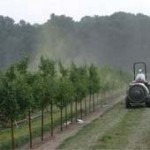
Monday 4:30pm
Heping Zhu, United States Department of Agriculture
“Current label-recommended levels of pesticides for spray application technology, pest pressure and crop growth structure are vague, frequently resulting in excessive use of pesticide,” says Heping Zhu from the USDA in Ohio.
His research in ornamental nurseries showed that when sprayers were optimised to allow accurate delivery, good insect and disease control could be achieved with 50% or less of label rates.
The work involved six different types of sprayers on 55 ornamental species over 500 hectares at five different commercial nursery fields.
Abstract
Efficacious insect and disease control with reduced active ingredient and carrier rate
H. Zhu, C. R. Krause
Application Technology Research Unit, USDA-ARS, Wooster, Ohio, United States
R. H. Zondag
Extension, The Ohio State University, Painesville, Ohio, United States
Current label-recommended levels of pesticides for spray application technology, pest pressure and crop growth structure are vague, frequently resulting in excessive use of pesticide. The objective of this research was to validate the hypothesis that pesticide use in ornamental nursery production could be greatly reduced by spray techniques.
Six different types of air-assisted sprayer were utilized to apply reduced rates and full rates of both active ingredients and carrier to control arthropod pests and diseases in ornamental nurseries. Sprayers were optimized with properly sized nozzles and operating parameters to match crop size.
Over 55 ornamental nursery species in 500 hectares at five different commercial nursery fields were involved in the investigation. Crop damage by various insects and diseases including spider mites, aphids, apple scab, and powdery mildew were surveyed for different application rates.
The studies revealed that insect and disease control using 50% or less of the label rates could be as effective as full rates when sprays were accurately delivered to targets, achieving real cost benefits to producers, consumers and environments.